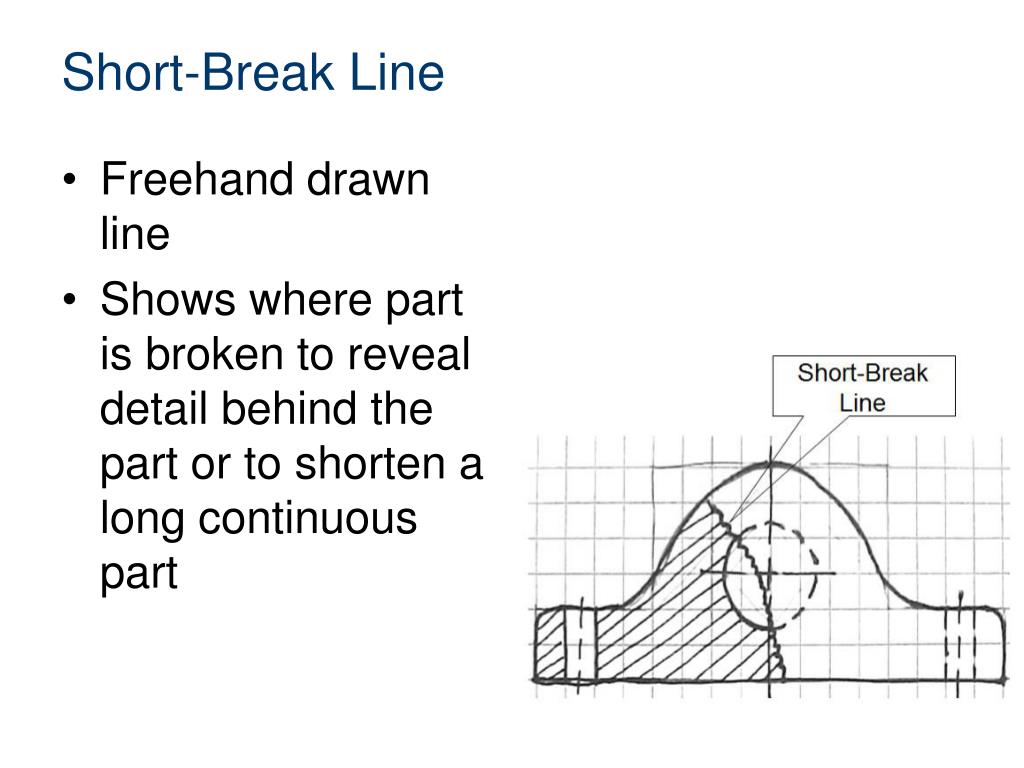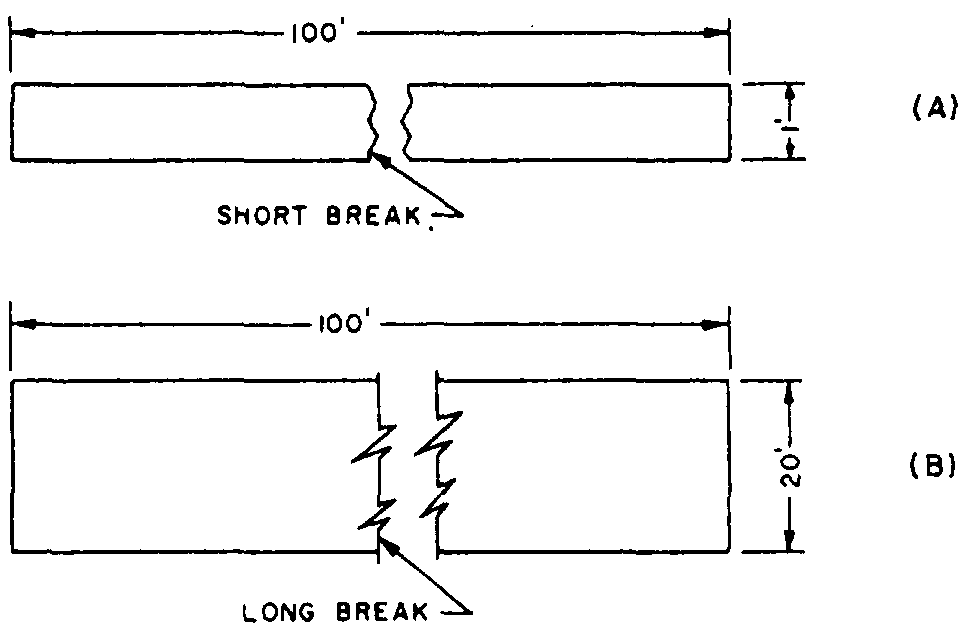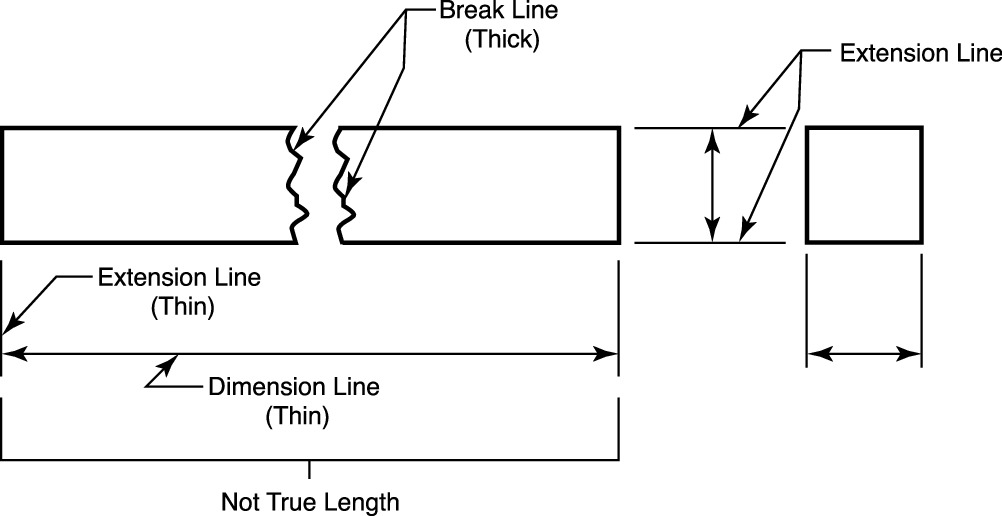Break Lines Engineering Drawing
Break Lines Engineering Drawing - Web table of contents types of lines 1. These lines indicate when a view has been broken. Used to break the edge or surface of a part for clarity of a hidden surface. The purpose is to convey all the information necessary for manufacturing a product or a part. If a part needs to be shortened with a.
Identify line types used in technical drawings interpret dimensioning on technical. Wall decor · fans · picture frames Engineering drawings use standardised language and symbols. Web engineering lines can be classified into several categories based on their purpose and representation. Web the most common types of lines in engineering drawings include: Engineering drawings come in many forms. By kelly curran glenn sokolowski.
Types Of Lines In Engineering Drawing
A thick wavy line used to break the edge or surface of a part to reveal a concealed surface. They define the outline or contour of the object. The purpose is to convey all the information necessary for manufacturing a product or a part. Short and long break lines are used for flat surfaces. There.
short break line drawing example cover
Line characteristics, such as widths, breaks in the line, and zigzags, all have definite meanings. They are dark and thick lines of any engineering design drawing. Section lines (hatching) are used in section views to represent surfaces of an object cut by a cutting plane. Wall decor · fans · picture frames Text is extended.
Engineering Drawing 2 Ch4 Conventional break YouTube
Feature’s corners and the end of the extension line. All thick lines are usually drawn 0.6 mm thick. Web if you choose the leaders tab, there is an option to ‘break lines’. On the other hand, break lines show a broken view without taking too much space. Web engineering lines can be classified into several.
short and long break lines
Web an engineering drawing is a drawing or a set of drawings that communicates an idea, design, schematic, or model. If a part needs to be shortened with a. Web engineering drawings (aka blueprints, prints, drawings, mechanical drawings) are a rich and specific outline that shows all the information and requirements needed to manufacture an.
How to draw a break line
All thick lines are usually drawn 0.6 mm thick. Short and long break lines are used for flat surfaces. Web the most common types of lines in engineering drawings include: A quiz completes the activity. Identify line types used in technical drawings interpret dimensioning on technical. Web table of contents types of lines 1. Engineering.
Different Types of LINES in Engineering Drawing//Classification of
All thick lines are usually drawn 0.6 mm thick. Web the most common types of lines in engineering drawings include: By kelly curran glenn sokolowski. Hidden lined (thick) hidden lined (thick) type lines consist of thick short dashes, closely and evenly spaced. On the other hand, break lines show a broken view without taking too.
AUTOCAD 2020 BREAKLINE SYMBOL HOW TO DRAW BREAK LINE SYMBOL YouTube
Why not just use a 3d model? Hidden lined (thick) hidden lined (thick) type lines consist of thick short dashes, closely and evenly spaced. There are various types of views in an engineering drawing. A thick wavy line used to break the edge or surface of a part to reveal a concealed surface. Identify line.
DRAWING BASICS
On the other hand, break lines show a broken view without taking too much space. Different types of engineering drawing views. Or other features with symmetric properties without cluttering the drawing. Web engineering lines can be classified into several categories based on their purpose and representation. In this highly interactive object, learners associate basic line.
short break line drawing examples pdf
Extension lines can annotate an area that is being measured. Web if you choose the leaders tab, there is an option to ‘break lines’. Web an engineering drawing is a subcategory of technical drawings. Web the continuous thin zigzag line shows a break line. On the end opposite the arrow, the leader line will have.
Break Line Architecture Drawing Short Break Line In Engineering
Request a quotebuilding materialsinstrument setsinterior design Web technically drawn 2 lines, lettering, and dimensions camosun college learning objectives by the end of this chapter, you should be able to: There are various types of views in an engineering drawing. Text is extended from this shoulder such that the text height is centered with the shoulder.
Break Lines Engineering Drawing Web basic types of lines used in engineering drawings. Used to break the edge or surface of a part for clarity of a hidden surface. Different types of engineering drawing views. Three types of break lines with different line weights: A freehand thick line, and a long, ruled thin line with zigzags.
Web Table Of Contents Types Of Lines 1.
Using break lines enables information to be. Dimension and extension lines are used to indicate the sizes of features on a drawing. A quiz completes the activity. They define the outline or contour of the object.
Web An Engineering Drawing Is A Subcategory Of Technical Drawings.
There are three types of break lines, each with a distinct line weight: Web basic types of lines used in engineering drawings. Web the most common types of lines in engineering drawings include: Line characteristics, such as widths, breaks in the line, and zigzags, all have definite meanings.
Engineering Drawings Use Standardised Language And Symbols.
Request a quotebuilding materialsinstrument setsinterior design Web break lines are drawn to show that a part has been shortened to reduce its size on the. In this highly interactive object, learners associate basic line types and terms with engineering drawing geometry. Hidden lined (thick) hidden lined (thick) type lines consist of thick short dashes, closely and evenly spaced.
The Purpose Is To Convey All The Information Necessary For Manufacturing A Product Or A Part.
Or other features with symmetric properties without cluttering the drawing. If a part needs to be shortened with a. A thick wavy line used to break the edge or surface of a part to reveal a concealed surface. All thick lines are usually drawn 0.6 mm thick.










